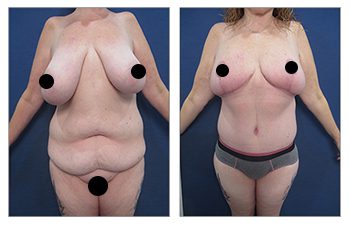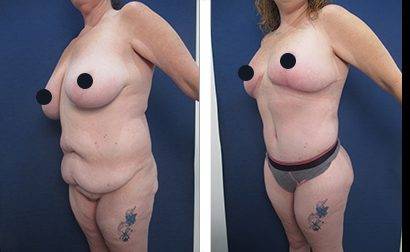


46-year-old female patient following a tummy tuck and lower body lift. Note the elimination of the FUPA.
What is a FUPA?
FUPA, or a Fatty Upper Pubic Area, is amongst the most commonly sought-after reasons for cosmetic surgery. As the acronym describes, a FUPA is a collection of adipose tissue, or simply put, fat, that is located between the hip bones, located in the pubic region. Childbirth, aging, rapid weight gain or weight loss, and genetics may contribute to the formation of a FUPA. FUPA can affect both males and females and is often a big point of contention.
FUPA in Females
In females, the FUPA often times most frequently appears after a Caesarean section. This proclivity follows the placement of a low-set incision, commonly known as a Pfannenstiel incision, which results in a retraction line of the skin and subcutaneous tissues down to the underlying muscle by way of scar tissue. This contracture, in turn, creates a contrast to the prominence of underlying fatty tissue in the pubic area.
FUPA in Males
In males, a FUPA often develops simply due to the obesity and subsequent growth of excess fatty tissue that resides in the pubic area.
Causes of FUPA
- Pregnancy – carrying a baby causes abdominal muscle separation and stretched skin, which can remain after birth
- C-sections – the horizontal incision interferes with proper healing and causes puckering
- Weight gain/loss – fluctuating weight can damage the elasticity of the skin causing it to sag
- Aging – skin loses collagen/elastin over time leading to laxity around the midsection
- Genetics – some people are predisposed to store fat in the lower belly/pubic region
Why is a FUPA a Concern?
In both males and females, the FUPA sticks out of clothes and creates an unsightly prominence. This can cause a person to feel self-conscious and embarrassed by their appearance. Additionally, excess fatty tissue in the pubic area can lead to discomfort when exercising or engaging in physical activities. A comprehensive list of symptoms include:
- Bulge, overhang, or apron-like fat under the belly button and above pubic bone
- Difficulty finding well-fitting clothing, bathing suits, jeans due to protruding pouch
- Discomfort moving around or performing exercises targeting core/abs
- Pain or irritation between folds of skin trapping moisture
- Poor body image, confidence, intimacy with a partner
FUPA Components
The common misconception regarding FUPA is that it is caused by simply fat. In fact, in reality, it is caused by a combination of fat as well as skin excess and often localized skin contracture. Undeniably, the excess fat is a leading factor. However, it is the tight horizontal contracture typically located along the lower belly line, termed the infra-abdominal crease, which contrasts the bulging fatty region that is often associated with redundant skin which is the real culprit. Several non-surgical corrections have been advocated to soften the overall appearance of the FUPA. These conservative approaches have included various exercises such as crunches, leg raises, rollups, superman poses, burpees, pelvic tilt, and classic Pilates moves that attempt to tone up your fat and skin. One should not minimize the importance of a healthy lifestyle to lose lower abdominal fatty tissue! Create a cardio routine, be mindful of what you eat, and de-stress with yoga and meditation. If these maneuvers have failed, it is time to consider surgery.
Correction of FUPA
Non-Invasive options
Diet and exercise can be an effective non-invasive approach for losing fat in the pubic area. This involves creating a sustainable caloric deficit through healthy eating habits and portion control. Performing targeted core exercises such as planks, leg raises, and knee tucks also helps strengthen and tone the muscles under excess fat. As the abdominal muscles become more defined, the overlying fat shrinks away. Committing to regular cardio workouts is also important for burning overall body fat.
EMSCULPT
EMSCULPT is a non-invasive body contouring procedure that uses high-intensity focused electromagnetic energy to stimulate supramaximal muscle contractions. This causes the muscle tissue in the treated area to adapt through growth of new protein strands and muscle fibers over the course of several weeks. EMSCULPT increases muscle mass while at the same time inducing lipolysis to reduce fat cells. Some common areas treated are the abs and buttocks. Patients undergo 30 minute sessions 2-3 times per week for 2-4 weeks. They may experience some mild soreness, swelling, or reddening which resolves quickly.
CoolSculpting
CoolSculpting also called cryolipolysis, is a popular non-surgical alternative to liposuction. It works by using controlled cooling panels set to freezing temperatures to selectively damage fat cells underneath the skin. The frozen fat cells enter apoptosis (automatic cell death) and are naturally flushed out of the body over the course of several weeks. Common treatment areas include the abdomen, flanks, back, arms, and thighs. Patients may experience some numbness, stinging, tingling, swelling, bruising, cramping, or aching during the first few days following the procedure. CoolSculpting produces gradual, natural-looking fat reduction without surgery or downtime.
Invasive surgical options
Invasive surgical options are also available for more dramatic, longer-lasting FUPA reduction. Pubic liposuction slims bulges by inserting a small cannula through tiny incisions to suction out excess fat deposits. General anesthesia is used for comfort. Swelling, bruising, and soreness are common side effects during the recovery period. Results are visible after about six weeks as the swelling subsides and treated area heals.
Monsplasty
Monsplasty is a procedure that reshapes the mons pubis. It involves removing excess skin and fat isolated to the pubic region. This provides a smooth, toned look to the area just above the pubic bone and vulva.
Panniculectomy
Like abdominoplasty surgery, a panniculectomy removes a large hanging fold or overhang of fat and skin below the belly button, effectively “flattening” the lower abdomen. The horizontal incision runs from hip bone to hip bone. For optimal contouring effects, a panniculectomy is sometimes combined with pubic liposuction. Recovery takes about six weeks with compression garments worn up to two months post-surgery to encourage skin retraction.
The goal of surgical correction of this is to create a gentle rather than a prominent convexity. The key to correction of a FUPA is to prevent an overdone appearance, such as a concavity. These goals are achieved by understanding whether the issue at hand is related to skin redundancy and excess fat. Excess fat may be addressed with liposuction of the FUPA while redundant skin may be addressed with an excision of the skin. FUPA skin excision is performed through a monsplasty and panniculectomy, or even a tummy tuck which will also address loose muscles in the belly. An incision allows for resetting of the height of the pubic area, providing a pubic lift, and enhancing the overall appearance of the pubis. Ideal pubic height ratios are based on the evaluation of super models; these distances extend from the inframammary crease to the belly button, the belly button to the upper groin crease, and upper groin to the bottom of the genitals, as 44%, 38%, and 18% respectively.
[Image]
From a technical standpoint, the key to a great result is acknowledging these ideal aesthetic height proportions, the underlying anatomy, and how to improve these proportions. Liposuction of the pubic region should be performed conservatively to prevent the formation of a concave or overdone appearance. In addition, care should be taken to avoid injury to the pudendal nerve which is responsible for erotic sensations. Addressing the FUPA in males enhances the overall appearance of male genitalia as it minimizes the surrounding tissue and showcases the male anatomy. Similarly, in females, addressing the FUPA will help showcase the female anatomy in an aesthetic manner!
Recovery and Results Following FUPA Corrective Surgery
- Recovery lasts 4-6 weeks with compression garment worn for up to 2 months
- Temporary side effects include swelling, bruising, numbness, pain, tiredness
- Visible results emerge over 3-6 months as swelling goes down and incisions heal
- Optimal results achieved after 6-12 months and can last several years
Cost of FUPA Corrective Surgery
The cost of FUPA correction can have a wide range that is dependent on whether you choose a non-invasive or invasive approach. Furthermore, the cost of FUPA surgery will also be directly related to the severity of your FUPA deformity which will determine the length of surgery. Finally, cost is affected by ancillary considerations listed below:
- Non-invasive: $2,000 to $4,000
- Surgical: $5,000 to $18,000
Ancillary Factors impacting overall cost:
- Extent of correction needed (amount of excess skin/fat)
- Type and combination of procedures
- Geographic location of surgeon and surgery center
- Additional fees like anesthesia, operating room, garments
Pros of FUPA Correction
- Improved comfort and mobility
- Boosted self-confidence
- Easier to find well-fitting clothes
- Reduction of rashes/infections
- More pleasurable intimacy
Cons of FUPA Correction
- Pain, soreness, swelling, bruising during recovery
- Visible scarring from surgical incisions
- Numbness around treated areas
- Post-op compression garment required temporarily
- Results may shift with future weight fluctuations
FUPA Conclusion
In summary, trying to reduce the size of your pubic mound can be frustrating despite exercise. But, at least there is peace of mind that if exercise and lifestyle changes don’t get you to where you need to be, there is always a surgical repair alternative. If you are bothered by your FUPA, we encourage you to consider undergoing a comprehensive evaluation to help you appreciate the best course of action for you.
